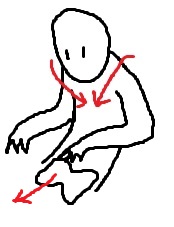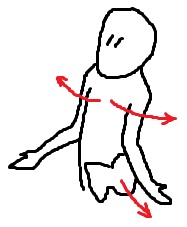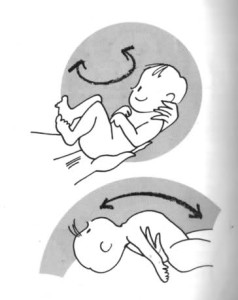I have been reading this brilliant book called Balance in Movement by Susanne Von Dietze (click here for the paperback or hardcover) in which she goes over in depth the biomechanics of rider posture in order to achieve balance while the horse is in movement.
Up until reading her book, I always explained the purpose of “thumbs up” as:
- it keeps the reins in a straight line from bit to elbow, so you can aid your horse most effectively
- it keeps the bones in your forearms parallel, which allows the hands to be more effective and sensitive
However, Von Dietze has introduced me to another reason:
- it initiates an erect trunk, so you can keep your balance
These are the concepts.
The Purpose Behind Thumbs Up
The body is interconnected. What you do with one thing affects another. Your pelvis angle affects your spine affects your shoulders.
Curling-in things are all related: pelvis tips back, spine rounds, pelvis tilts down, shoulders slump, head and neck push forward, hands face down. Think sitting at a computer!
Stretching-out things are all related: pelvis tilts forward, back arches, shoulders come back, chest sticks out, hands face palm out. Think a good stretch in the morning.
Interestingly (I noticed) these are similar to the tonic labyrinthine reflex (TLR), a primitive reflex in newborns. Eventually this reflex is overridden, but in some people with disabilities you will see it persist as abnormal extension patterns or muscles tone.
(Source: Sasse, M.(2002) Tomorrow’s Children. Toddler Kindy GymbaROO)
So, muscles work in chains, never alone!
You turn your hands out, and everything else turns out. (stretch)
You turn your hands down/in, and everything else curls in around it. (flex)
In riding we want neither extreme, we want the balanced centered position in which the hands are held with the thumbs up, because this initiates an erect trunk, which helps one balance. Thumbs in and palms down causes the rider to curl in and their muscles to flex. Thumbs out causes the rider to turn everything else in the body out.
If you try this at home, you may feel it, or you may not – many of us override the connections, but I notice when I ride and my palms face down, often I start looking down, and leaning forward.
To go further, she says the that thumbs on top hold the rein between it and the index finger, so the rest of the fingers can communicate independently with the horse’s mouth.
Also, the thumb is slightly bent like a roof to keep the wrist free from tension, so you can move it more freely. A flat pressing thumb creates tension in the wrist.
Implications
I think that for therapeutic riding instructors, these are the implications:
- Sitting up straight starts with the pelvis: get it in the right angle, and the rest will follow.
- Encourage riders to bring their shoulders back over their hips, and their ribs back under their shoulders, like stacking up blocks.
- In warm-ups include seat, spine, and chest awareness and mobility, in particular opening up the chest. Hands are only as good as the seat, so work on a good seat and independent arms and hands first.
- Use a grab strap to develop and independent seat, holding it with the thumbs up and pulling out as if to stretch it, which opens up the chest. Pulling up can help create a deep seat. Hold steady with even pressure to develop feel. Don’t worry about pulling, the grab strap is primarily to develop a good seat, not good hands, she says. Practice moving the hands forward during upward transitions without losing balance.
- Some riders with disabilities will show the open and close reflexes more than others, but with all of them you can help manipulate their bodies into the correct position by focusing on the pelvis, spine, shoulder, and hand angles.
Have you found this to be true?
Happy teaching!
****************
Note: This is not professional advice, this is a blog. I am not liable for what you do with or how you use this information. The activities explained in this blog may not be fit for every rider, riding instructor, or riding center depending on their current condition and resources. Use your best personal judgment!



Thank you, Cindy! That was really informative and makes good sense!!!